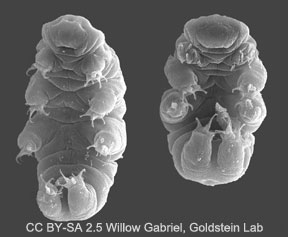
Tardigrades Are Invincible – Learn Stuff
There are critters out there that can survive the vacuum of space, gamma radiation, and mind-blowing temperatures and pressure. They aren’t cockroaches, spiders, or even some microscopic organism. These environmentally resistant creatures are tardigrades, and while they aren’t technically invincible, they come really close.
It wasn’t that long ago that most people had never heard of tardigrades. They came to be more in the public consciousness since 2015 because of popular media, appearing in Ant Man, Harbinger Down, South Park, Family Guy, and Star Trek Discovery. It seems writers jumped on the same bandwagon.
Tardigrades were first discovered by a German zoologist named Johann August Ephraim Goeze (pictured) in 1773. He took a look at these things and named them Kleiner Wasserbär, which translates to “little water bear”. This name stuck, as even today most people refer to them as water bears. Some people call them moss piglets, but I don’t get it because they don’t look like bears or pigs at all.
In 1777, a much more reasonable Italian biologist named Lazzaro Spallanzani called them “tardigrada”, which means “slow steppers/walkers”.
Adult tardigrades grow to an average of .5 mm, so even a low-power microscope will give you a good view. Their eight legs end in either claws or suction disks. There are about 1,300 known species, and they can be found literally anywhere. Most feed on plant matter or bacteria, though there are some that eat smaller tardigrades.
Life expectancy ranges from a few months, up to two years. This can be extended to decades however, as Tardigrades have the ability to lower their metabolism to .01% of normal and can go without food or water for more than 30 years in that state. These micro-animals have been around for a long time. Specimens have been found on the east coast of the U.S. that are 90 million years old.
As remarkable as that is, their claim to fame is the extreme conditions which they can endure.
Temperature
High temperatures bother Tardigrades more then low ones, but the numbers are impressive regardless. Cranking the heat up to 304°F (151°C) will kill a water bear in a matter of minutes, but that’s still pretty wild. On the other end of the spectrum, a few minutes at -272°F (-458°) will also do them in. That’s ONE Kelvin. They can withstand -328°F (-200°C) for days, and can go 30 years at -4°F (-20°C).
Pressure
Pressure (or lack thereof) doesn’t seem to bother Tardigrades very much. They can survive the vacuum of space after all. Some species can handle pressures up to 6,000 atmospheres, which is almost six times greater than the bottom of the Mariana Trench. Scientists have found they can survive altitudes of over 19,600 feet (6000 meters), and depths of 15,000 feet (4,700 meters).
Impact
These tough little buggers can withstand impacts up to 900 meters per second. That’s about the average velocity of a .300 Winchester magnum.
Radiation
Tardigrades can withstand 1000 times more radiation than any other creature. It takes 5000 grays of gamma rays and 6,200 grays of heavy ions to kill them. This is the same stuff that creates super heroes. It only takes five to ten grays of either to kill a human.
If you want to check out tardigrades for yourself, they aren’t hard to find. Go get some moss and stick it in a dish with water. Within 24 hours, you should have a bunch of active little water bears. Healthy environments can see a Tardigrade population of 25,000 per liter of water.




















